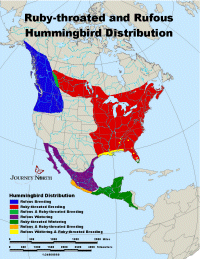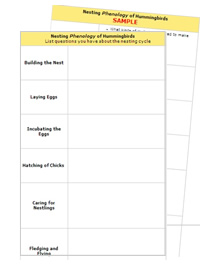| Please
Report Your Sightings! |
Rufous hummingbirds are on the move into western Montana this week. One rufous even has a name; he's called "Glitterpants." Storms and rain caused a "fall out," and 89 new rubythroat sightings reported. High speed cameras allow us to learn new things about hummingbirds. A "Nature" video shows how. And what do you want to know about the hummingbird nesting cycle? Plug in to this important part of the hummingbird's life cycle.
Today's Report Includes:
- Highlights, Maps, and Questions
- Explore: High Speed Photography and Nature's "Super Heroes"
- Explore: Nesting Phenology of Hummingbirds
- Year-end Evaluation: Please Share Your Thoughts
Highlights:
Hummers
Reaching New Territory!
Rufous hummers were pushing further eastward this week with 3 sightings
in western Montana, including for one rufous named, "Glitterpants!"
The rufous hummers in Missoula must be headed northward up the Flathead
valley. Spotters in Polson (at the southern end of the Flathead Valley)
might have seen Glitterpants 2 days later when they reported their first
hummer.
One enthusiastic New Jersey observer was rewarded, "Had 2 feeders out for weeks. Increased feeders daily and had 10 out when the ruby bird showed this morning. A female - one fast drink and gone."
Which
Hummer is Which?
An Oregon reporter sent this comment, "Dueling Rufous hummers
are fencing with rubythroats at the feeder." What do you think? Did
you guess that the viewer has their hummingbird species mixed up? We know
that Oregon isn't included in the rubythroat hummingbird breeding range.
However, there are 8 species of hummingbirds found in Oregon. We think
they might have mistaken a broad-tailed
hummer for a rubythroat. Next week we'll explore the various hummingbird
species found in the Americas.
 Distribution Map |
||
| Rufous
|
Ruby-throated
|
|
| Handouts:
Today's Hummingbird Map Questions Rufous Questions Rubythroat Questions |
||
"We think hummingbirds are these delicate, fragile little birds, but that's not true at all," reports filmmaker, Ann Prum. Science and technology have come together in a new way to help us get to know hummingbirds like never before.
Working with hummingbird scientists, Ms. Prum's cameras were able to slow down movements of the speedy little bird so we can learn more about their behavior. "I think hummingbirds are nature's super heroes," writes Ms. Prum.
Video
Set aside 9 minutes to view this video. As you watch, look for clues
that support her statement about super heroes.
- Nature: Behind the Scenes of Hummingbirds/PBS (9 minutes)
Why you think hummers might be called "super heroes." Use your journals to write your thoughts.
View the full episode from the Nature series: Hummingbirds: Magic in the Air
It's nesting season! As hummingbirds are arriving across their breeding range let's explore and learn about their nesting cycle.
What questions do you have about their nesting cycle?
- Use this concept chart to organize your questions about each stage of the cycle. Then take our research challenge!
Dig
into hummingbird materials!
Collect fascinating
facts about the hummingbird's nesting cycle. Then share your writing project
with others. Use the links below to get started:
Will you take a few minutes to complete our Year-end Evaluation? With your help, we can we document Journey North's reach, impact and value. We need comments like yours to keep the program going and growing.
-
Year-end Evaluation: Please Share Your Thoughts

- Explore: Nesting Concept Chart
- Video: Nature: Behind the Scenes of Hummingbirds/PBS
- Predict: Spring 2010 Prediction Chart
- Predict: When Will Your Hummingbird Arrive?
- Hummingbird Migration Journals (click-and-print)
- Hummingbirds for Kids (booklets, photos, videos)
- Cool Hummingbird Facts: Questions Asked by Students, Answered by Experts
- Teachers: Get Started with the Hummingbird Migration
The Next Hummingbird Migration Update Will Be Posted on May 5, 2010.










